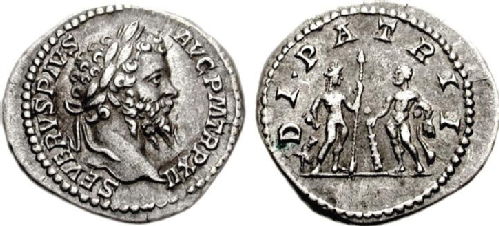All 1 entries tagged Septimius Severus
No other Warwick Blogs use the tag Septimius Severus on entries | View entries tagged Septimius Severus at Technorati | There are no images tagged Septimius Severus on this blog
March 01, 2015
Septimius Severus and his DI PATRII Coinage: A Tale of Two Identities
 |
| Denarius of Septimius Severus (CNG Mail Bid Sale 73, lot 943) |
For the most part, research of the Roman concept of patria (definable as a complex embodiment of Roman collective identity) is dominated by the analysis of literary and epigraphic data. Offering a fresh perspective on this important concept is a single coin type, the only one from the Roman world in fact to bear the word patria in its legend outwith the imperial title pater patriae. Minted between AD 200 and 204 by the emperor Lucius Septimius Severus (emperor from AD 193-211) and his sons Geta and Caracalla in a variety of denominations, the obverse depicts (in this case) the bust of the emperor and bears the legend SEVERVS PIVS AVG. P.M. TR.P. XII (Severus Pious Augustus, Pontifex Maximus, holder of the Tribunician Power for the twelfth time). On the reverse are depicted two gods. Facing to the right is Liber Pater. In his hands he holds a cup and thyrsus (a wand or staff), and at his feet sits a panther. Facing to the left is Hercules, clearly identifiable by the club and lion skin. They are accompanied by the legend DI PATRII (gods of the patria).
In order to explain the significance of this coin type, three interpretations have so far been proposed, all of which rightly identify the coin type’s function as a visual representation of the emperor’s identity. Firstly, the German scholar Hasebroek has suggested that the coin could have been struck to commemorate Severus’ visit to Africa in AD 204, which would have included a stop off at the city of Lepcis Magna. Lepcis Magna was the patria of Severus, and its tutelary gods were Shadaphra and Melqart, the Lepcitanian equivalents respectively of Liber Pater and Hercules. However, this interpretation has recently been discarded due to the fact that evidence suggests Severus’ African tour took place in AD 207, three years after the latest issuing of the DI PATRII coin type. A second suggestion has been put forward by Barnes, who has argued that the coin was struck to commemorate the commencement and dedication of a temple to the gods Liber Pater and Hercules at Rome. However, very little physical evidence exists for us to be entirely sure that such a temple was constructed. Most recently, Rowan has expanded on Barnes’ argument, and has proposed that the coin marks the moment in which Liber Pater and Hercules became the di patrii of Rome.
So does the coin indicate the emperor’s Roman identity or his African origins? I would argue that the coin simultaneously represents both. Iconographically, the coin would appear to symbolise Severus’ African birthplace, and hence identity. As stated above, Liber Pater (Shadaphra) and Hercules (Melqart) were the tutelary deities of Lepcis Magna. This is indicated by several inscriptions from the city, their prominence in Lepcitanian sculpture and the fact that their temples occupied central locations within the old forum. It is also clear that the gods were important to Severus on a personal level, being also the tutelary deities of his regime, appearing in several other coin issues during his reign. Furthermore, whilst the joint appearance of Liber Pater and Hercules is identifiable in the coinage of Lepcis Magna from the first century BC to the first century AD, this is the first time that these gods appear together in any form on Roman coinage.
Iconographically, therefore, the coin seems to proudly display Severus’ Lepcitanian identity. Surely, therefore, the legend DI PATRII must correspond to them also, stressing their role as the tutelary gods of his African patria? A consideration of epigraphic and literary evidence would seem to question this argument. Epigraphically, the legend DI PATRII is one that is very rarely found outside of Rome or Italy. With regard to the inscriptions in Lepcis Magna that refer to Liber Pater and Hercules, only one describes them in this way. Their most common epigraphic description is instead either GENII COLONIAE (guardian deities of the colonia) or DIBVS LEPCIS MAGNAE (gods of Lecpis Magna). In literature also, the phrase di patrii appears to have been used almost exclusively in relation to the gods of Rome, particularly with regards to the penates that were according to legend brought to Italy from Troy by Aeneas. Consequently, the phrase is frequently identified in Virgil’s great ‘national’ epic The Aeneid. It is also prominent, to give only one further example, within the speeches of Cicero, an individual who places particular emphasis upon the fundamental relationship between res publica and patria in his writings.
This coin, therefore, can be seen to symbolise Severus’ local Lepcitanian identity alongside his that of his role as the cultural and religious leader of the Roman world. However, how do we contextually account for this apparent dual-identity? As stated above, this coin type was issued between AD 200 and 204. In AD 204, the Saecular Games were held. This event occurred every 110 years (although there was much flexibility in this) and marked the beginning of a new saeculum (era). The games were a moment in which to celebrate the continuation of Roman power and religious identity but they often contained elements of novelty reflecting the theme of a new beginning. Yet, exactly how does the coin fit into this context of tradition accompanied by novelty? The coin’s legend DI PATRII is clearly a nod to Roman tradition, since, as we have seen from the literary passages, it was a phrase that had important connotations to Roman collective identity. The iconography, however, indicates novelty. It is the first time that these two gods appear together on a single Roman coin, and they clearly stress the emperor’s pride in his native, and hence non-Roman, origins. It is true that other emperors also displayed personal deities on coinage during such events, but they did so with Roman religious iconography firmly in mind, and there is no indication that in doing so they are making a direct reference to their native origins, their local patriae. Thus, issued at a time which celebrated Romanitas, I would advocate the interpretation that Severus’ DI PATRII coinage is a wonderful statement of the equal importance that was placed upon local and imperial identities, proudly displaying the emperor’s attachment to his local patria, whilst also honouring the religious elements that were at the heart of Rome’s conceptualisation of patria.
 This month's coin is contributed by Alexander Peck. Alex is currently a third year PhD student in the Department of Classics and Ancient History at the University of Warwick. His thesis examines the Roman concept of the patria. It considers the ways in which it was conceptualised by the Romans; how this conceptualisation changes over time; how the concept was institutionalised; and the concept’s role within Roman politics. He obtained his first degree, a first class MA (Hons) in Classics and Italian, from the University of Glasgow in 2012. He has a great interest in interdisciplinary collaboration on the subject of collective identity, especially on the question of the origins and evolution of nationalism. He is currently the editor for a forthcoming volume for Pickering and Chatto’s Warwick Series in the Humanities entitled Nationhood: From Antiquity to Modernity.
This month's coin is contributed by Alexander Peck. Alex is currently a third year PhD student in the Department of Classics and Ancient History at the University of Warwick. His thesis examines the Roman concept of the patria. It considers the ways in which it was conceptualised by the Romans; how this conceptualisation changes over time; how the concept was institutionalised; and the concept’s role within Roman politics. He obtained his first degree, a first class MA (Hons) in Classics and Italian, from the University of Glasgow in 2012. He has a great interest in interdisciplinary collaboration on the subject of collective identity, especially on the question of the origins and evolution of nationalism. He is currently the editor for a forthcoming volume for Pickering and Chatto’s Warwick Series in the Humanities entitled Nationhood: From Antiquity to Modernity.
Coin image reproduced courtesy of Classical Numismatic Group Inc., (Mail Bid Sale 73, lot 943) (www.cngcoins.com)
 Clare Rowan
Clare Rowan

 Please wait - comments are loading
Please wait - comments are loading

 Loading…
Loading…



